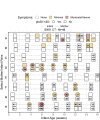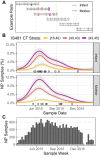Asymptomatic Bordetella pertussis infections in a longitudinal cohort of young African infants and their mothers
- PMID: 34097599
- PMCID: PMC8184211
- DOI: 10.7554/eLife.65663
Asymptomatic Bordetella pertussis infections in a longitudinal cohort of young African infants and their mothers
Abstract
Recent pertussis resurgence in numerous countries may be driven by asymptomatic infections. Most pertussis surveillance studies are cross-sectional and cannot distinguish asymptomatic from pre-symptomatic infections. Longitudinal surveillance could overcome this barrier, providing more information about the true burden of pertussis at the population level. Here we analyze 17,442 nasopharyngeal samples from a longitudinal cohort of 1320 Zambian mother/infant pairs. Our analysis has two elements. First, we demonstrate that the full range of IS481 qPCR CT values provides insight into pertussis epidemiology, showing concordance of low and high CT results over time, within mother/infant pairs, and in relation to symptomatology. Second, we exploit these full-range qPCR data to demonstrate a high incidence of asymptomatic pertussis, including among infants. Our results demonstrate a wider burden of pertussis infection than we anticipated in this population, and expose key limitations of threshold-based interpretation of qPCR results in infectious disease surveillance.
Keywords: Africa; Bordetella pertussis; asymptomatic infection; cohort study; epidemiology; global health; human; qPCR; whooping cough.
© 2021, Gill et al.
Conflict of interest statement
CG, CG, WM, LM, DT, RP, GK, ZM, PR No competing interests declared
Figures










Similar articles
-
Asymptomatic Bordetella pertussis infections in young African infants and their mothers identified within a longitudinal cohort.medRxiv [Preprint]. 2020 Nov 19:2020.11.18.20231423. doi: 10.1101/2020.11.18.20231423. medRxiv. 2020. PMID: 33236026 Free PMC article. Updated. Preprint.
-
Incidence of Severe and Nonsevere Pertussis Among HIV-Exposed and -Unexposed Zambian Infants Through 14 Weeks of Age: Results From the Southern Africa Mother Infant Pertussis Study (SAMIPS), a Longitudinal Birth Cohort Study.Clin Infect Dis. 2016 Dec 1;63(suppl 4):S154-S164. doi: 10.1093/cid/ciw526. Clin Infect Dis. 2016. PMID: 27838668 Free PMC article.
-
Bordetella pertussis Infection in South African HIV-Infected and HIV-Uninfected Mother-Infant Dyads: A Longitudinal Cohort Study.Clin Infect Dis. 2016 Dec 1;63(suppl 4):S174-S180. doi: 10.1093/cid/ciw527. Clin Infect Dis. 2016. PMID: 27838670 Free PMC article.
-
Pertussis in the Association of Southeast Asian Nations: epidemiology and challenges.Int J Infect Dis. 2019 Oct;87:75-83. doi: 10.1016/j.ijid.2019.07.016. Epub 2019 Jul 29. Int J Infect Dis. 2019. PMID: 31369823 Review.
-
Resurgence of pertussis: Epidemiological trends, contributing factors, challenges, and recommendations for vaccination and surveillance.Hum Vaccin Immunother. 2025 Dec;21(1):2513729. doi: 10.1080/21645515.2025.2513729. Epub 2025 Jun 9. Hum Vaccin Immunother. 2025. PMID: 40491090 Free PMC article. Review.
Cited by
-
Epidemiology of Pertussis After the COVID-19 Pandemic: Analysis of the Factors Involved in the Resurgence of the Disease in High-, Middle-, and Low-Income Countries.Vaccines (Basel). 2024 Nov 28;12(12):1346. doi: 10.3390/vaccines12121346. Vaccines (Basel). 2024. PMID: 39772008 Free PMC article.
-
Prior exposure to B. pertussis shapes the mucosal antibody response to acellular pertussis booster vaccination.Nat Commun. 2022 Dec 2;13(1):7429. doi: 10.1038/s41467-022-35165-w. Nat Commun. 2022. PMID: 36460655 Free PMC article.
-
Assessment of Pertussis Underreporting in Italy.J Clin Med. 2023 Feb 21;12(5):1732. doi: 10.3390/jcm12051732. J Clin Med. 2023. PMID: 36902519 Free PMC article.
-
Modeling Immune Evasion and Vaccine Limitations by Targeted Nasopharyngeal Bordetella pertussis Inoculation in Mice.Emerg Infect Dis. 2021 Aug;27(8):2107-2116. doi: 10.3201/eid2708.203566. Emerg Infect Dis. 2021. PMID: 34286682 Free PMC article.
-
Secrets and lies of host-microbial interactions: MHC restriction and trans-regulation of T cell trafficking conceal the role of microbial agents on the edge between health and multifactorial/complex diseases.Cell Mol Life Sci. 2024 Jan 13;81(1):40. doi: 10.1007/s00018-023-05040-y. Cell Mol Life Sci. 2024. PMID: 38216734 Free PMC article. Review.
References
-
- Armangil D, Tekinalp G, Yurdakök M, Yalçin E. Maternal pertussis is hazardous for a newborn: a case report. The Turkish Journal of Pediatrics. 2010;52:206–210. - PubMed
-
- Bolotin S, Quinn H, McIntyre P. Epilogue. In: Rohani P, Scarpino S. V, editors. Pertussis: Epidemiology, Immunology and Evolution. Oxford University Press; 2018. pp. 1–2. - DOI
Publication types
MeSH terms
Substances
Grants and funding
LinkOut - more resources
Full Text Sources
Medical

